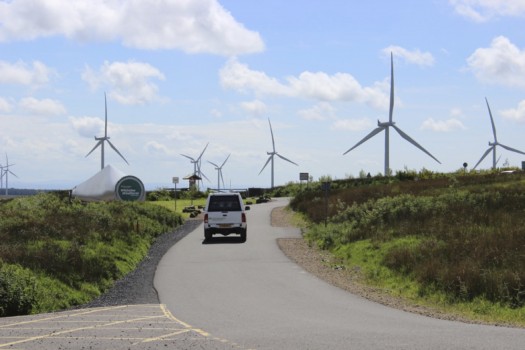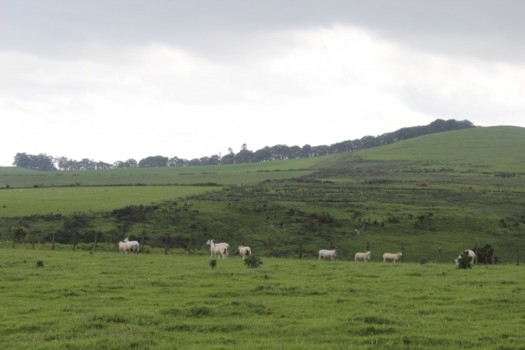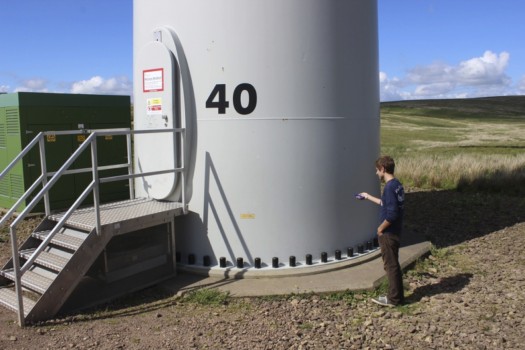During the summer of 2014, Alumni Memorial Scholar (AMS) Alex Rojek ’15 used his AMS Grant to study the growing impact of wind energy in Scotland. By traveling throughout the Highlands–including the Cairngorms National Park–he hoped to better understand the impact wind farms have on the local economy, environment, and public opinion. You can learn more by attending his presentation at the fall AMS Symposium, scheduled for November 18, 2014.

Entrance to Whitelee Wind Farm, Eaglesham
It was obvious from the moment I stepped off the airplane in Glasgow that I was entering a place with a completely different perspective on energy and sustainability. Airport employees were driving around in “Zero Emission Vehicles Powered by Lithium-Ion Technology” (They were also present all around the city of Glasgow too, serving as transportation for city employees). When I rented a vehicle in order to travel to various sites at opposite corners of the country, I was amazed by the fuel economy of the diesel engine (well over 60 mpg!). Many restaurants I encountered embraced the “locavore” movement in a way that was totally foreign to me (One server detailed the exact origin of each one of the ingredients in my meal—all within 20 miles of the restaurant!). One of the wind farms I visited in my study acted not only as a generator of power for half the city of Glasgow, but as an educational and recreational center (more on this later!).
Overall, Scotland seemed to have embraced the culture of sustainability to a degree that has not yet been reached stateside. While the sustainability movement in the USA is certainly gaining ground, it is not quite as pervasive as in the land of our neighbors across the pond (and a little to the north). Scotland has much more to offer than kilts and haggis—its impressive dedication to sustainability sets an example for the rest of the world to follow. This fact is becoming increasingly well known around the world, and it was a major reason that I chose to perform a study of the public perception of wind power in Scotland.

Proposed site of Nathro Hill Wind Farm, not far from Cairngorms National Park boundary and near a main tourist route across the eastern side of the nation. At the time of my visit, this was one of the most hotly-contested proposed sites in Scotland. Very recently, largely as a result of the controversial location, the proposed construction was cancelled.
Cairngorms National Park, in the north of Scotland, is home to some of the most breathtaking scenery on earth. The sheer natural beauty and wildlife of the region, recognized by people all across Scotland and the greater United Kingdom, is truly something to be treasured. As such, it was unsurprising to hear that the proposed construction of several wind farms near the boundaries of the park was being met with resistance from the local people. I set out to determine if the general population truly held this belief (as opposed to simply “those who yell the loudest…”) and to find out if there was a deeper rationale for opposition than what appeared on the surface.
My fortnight in Scotland began in Glasgow, and traversed the majority of the country, going as far north as Inverness and as far east as Aberdeen and Edinburgh. Major stops included Carrbridge, Grantown-on-Spey, and Kirriemuir (all on the fringes of Cairngorms National Park and near proposed wind farm construction sites), as well as Eaglesham (home to Whitelee Wind Farm, the UK’s largest on-shore wind farm).
Whitelee Wind Farm was perhaps the most interesting (and potentially even my favorite!) place I visited while in Scotland. Yes, I am saying that a part of me may have enjoyed my time at a wind farm more than the numerous medieval castles and natural wonders I made time to see. The creators of Whitelee took formerly unused land and built something truly spectacular. They not only built a plant that supplies power to half of Glasgow, but they developed what seemed to be a cultural phenomenon. Miles upon miles of walking/running trails wound among the turbines, and a new mountain bike track was recently completed. The previously useless plot of land had been transformed into a remarkably aesthetically pleasing and recreationally viable area. In addition to this, it has also become an educational powerhouse. The visitors center now offers tours of the grounds several times each day, and has several hands-on-learning exhibits to help explain how wind power can help change the world. All in all, I don’t see how it could be possible for someone to visit Whitelee and walk away not seeing wind power as the answer to the energy crisis.

Me, taking a sound recording at the base of turbine #40 at Whitelee Wind Farm in Eaglesham.
While at Whitelee, I toured the grounds and recorded several audio files standing at various distances from wind turbines. A common fear the general population possesses of wind farms is that the noise pollution generated will negatively impact the quality of life in the surrounding areas. I found, however, that at a distance of as little as 100 yards from the base of a turbine, the noise was rather minimal and did not affect the volume at which I had to speak to hold a conversation. By walking only a bit farther from the turbine, the noise all but disappeared. Therefore, from my judgments, unless one is thinking about erecting a turbine in close proximity to his home, he need not worry about noise.
Through my travels, I learned a great deal about the renewable energy movement in Scotland, and the rationale behind the rather strong opinions about it—both for and against.
A large part of my data gathering was done through an informal interview process, through which I would casually mention either a local wind farm or the concept of renewables to a regular Scottish citizen and take note of his or her response. This proved, rather effectively, how simple conversations could be transformed into a gauge of popular opinion in a certain area. Though it would be unfair to overgeneralize, I found Scottish views on wind farm construction to be positive on the whole, while opinions on wind farm construction near the Cairngorms specifically were resoundingly negative.
People from all walks of life across each area I visited supported renewable energy overwhelmingly. They really seemed to understand that fossil fuels were finite and that something needed to be done to provide power in a different way. Hydroelectricity as well as wind power were constantly brought up as excellent ways to generate electricity in the stead of fossil fuels..
The southern area of Scotland (near Glasgow and Edinburgh) is not particularly prized for its natural beauty or wildlife, and as such seems to be prime wind farm real estate. Whitelee Wind Farm, discussed previously, was built 20 minutes outside of Glasgow on previously unused land and has resulted in an economic boom for the area as well as valuable recreational and educational facilities. The proposed site of Fauch Hill Wind Farm, not far from Edinburgh, was strongly supported by all the locals with whom I spoke. The plot of land on which it is to be built, though aesthetically appealing in its own right, possesses no real value to the people of Scotland. Because they don’t see it as a source of national pride, they are largely in favor of making it something to be proud of in another way. Similar attitudes are held toward off-shore wind farms, as not a single person I met opposed them. The general opinion seemed to be that land (and water) not directly part of a city or the cherished highlands region could be used in a manner that benefited Scotland, and the planet as a whole.
Though quite impressive, this fervor for taking unused plots of land and transforming them into valuable energy-generating areas, was completely overpowered by reverence for the wild lands of the highlands region and Cairngorms National Park. A Grantown-on-Spey resident put it rather bluntly, in a way that made me truly appreciate how strongly the Scottish feel about protecting the Cairngorms region:
“How would you feel if you went home and found 60 giant wind turbines right next to the Grand Canyon? The people of America would never let that happen and you know it. That’s how we feel about the Cairngorms here.” –Granton-on-Spey resident
My time in Scotland taught me many things. It served to strengthen my belief that renewable energy is an important part of our planet’s future, but it also taught me that people respond rather strongly when things they hold dear are threatened. The Scottish people love the Cairngorms. They love them the way they are, in all their natural splendor. No desire for an increase in renewable energy seemed able to supersede that.




